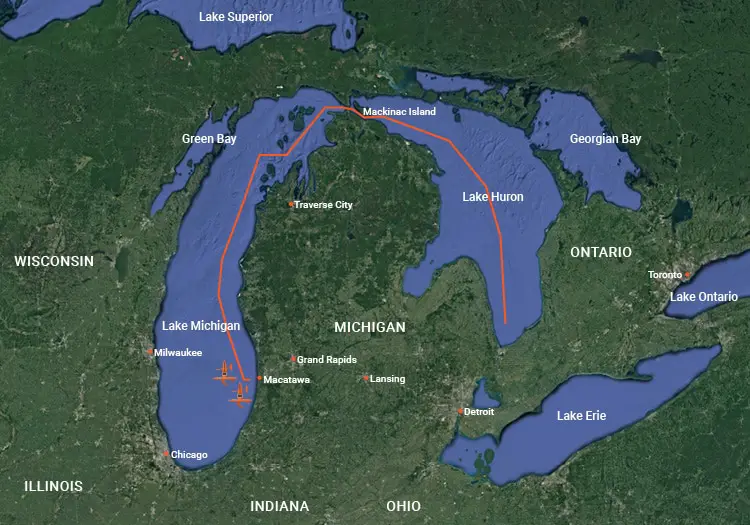The Sunshine State, as Florida is affectionately known, offers numerous attractions: from its rich history and culture to its stunning natural beauty and diverse climates. But along with its many benefits, Florida also faces a major weather-related challenge: severe hurricanes. The historical, environmental, and societal impact of these natural disasters in the state presents a complex web that needs unravelling. This examination will journey through Florida’s history, painting a picture of the most damaging hurricanes and their profound effects. It will delve into the causes and predispositions, giving a detailed account of why Florida is a hotspot for these fierce storms, while also elucidating how they shape the local ecosystems, economies, and communities. Further, it will offer insights into hurricane preparedness, response, and recovery measures, in order to understand the resilience of Floridians in the face of adversity. Lastly, it will shed light on the future outlook of hurricanes in Florida, taking into account climate change predictions, and outlining adaptation strategies going forward.
Historical Perspective of Severe Hurricanes
Florida’s Vulnerability to Severe Hurricanes
Florida boasts over 1,300 miles of coastline, making it highly vulnerable to severe hurricanes. The state’s geography, sandwiched between the Atlantic Ocean and the Gulf of Mexico, makes it a common target for tropical cyclones. Historically, severe hurricanes have wrought havoc on the state from the 1800s to the present day.
A History of Destruction: Major Events Since the 1800s
Severe hurricanes in Florida’s past have claimed many lives and caused significant damage. In the late 1800s to the early 1900s, four severe hurricanes led to a death toll of over 8,000 and left a trail of destruction in their wake. The 1928 Okeechobee Hurricane, with a death toll of 2,500, remains one of the deadliest natural disasters in U.S. history.
Changes Over Time in Hurricane Intensity
While Florida has experienced severe hurricanes for centuries, there has been a notable increase in the intensity of these storms. Starting from the 1980s, hurricanes in Florida have shown an upward trend in their intensity due to rising sea temperatures caused by climate change. This change has seen stronger, category 4 and 5 storms like Hurricane Andrew in 1992 and Hurricane Irma in 2017 impacting the state.
The Worst Hurricanes in Florida’s History
Some storms stand out in Florida’s history due to their severe devastation. Hurricane Andrew, hitting in August 1992, claimed 65 lives and caused an estimated $27.3 billion in damage, making it the costliest disaster in U.S. history at the time. More recently, Hurricane Irma in 2017 resulted in 84 deaths and $50 billion in damage, making it the fifth costliest U.S. hurricane.
Hurricane Preparedness and Adaptation Over Time
Florida’s history with severe hurricanes has necessitated the evolution of disaster preparedness and response mechanisms. With the memory of past disasters like Hurricane Andrew, building codes have been updated to ensure structures can withstand severe weather. Efforts to improve forecasting and emergency response mechanisms have become crucial to mitigate the impact of these storms.
The reality of severe hurricanes is an inherent part of life for those living in Florida. Understanding the history and impact of these compelling storms in relation to the state is crucial, especially in light of the continuous influence of climate change on hurricane intensity. This knowledge is vital for effective future planning and disaster management strategies.
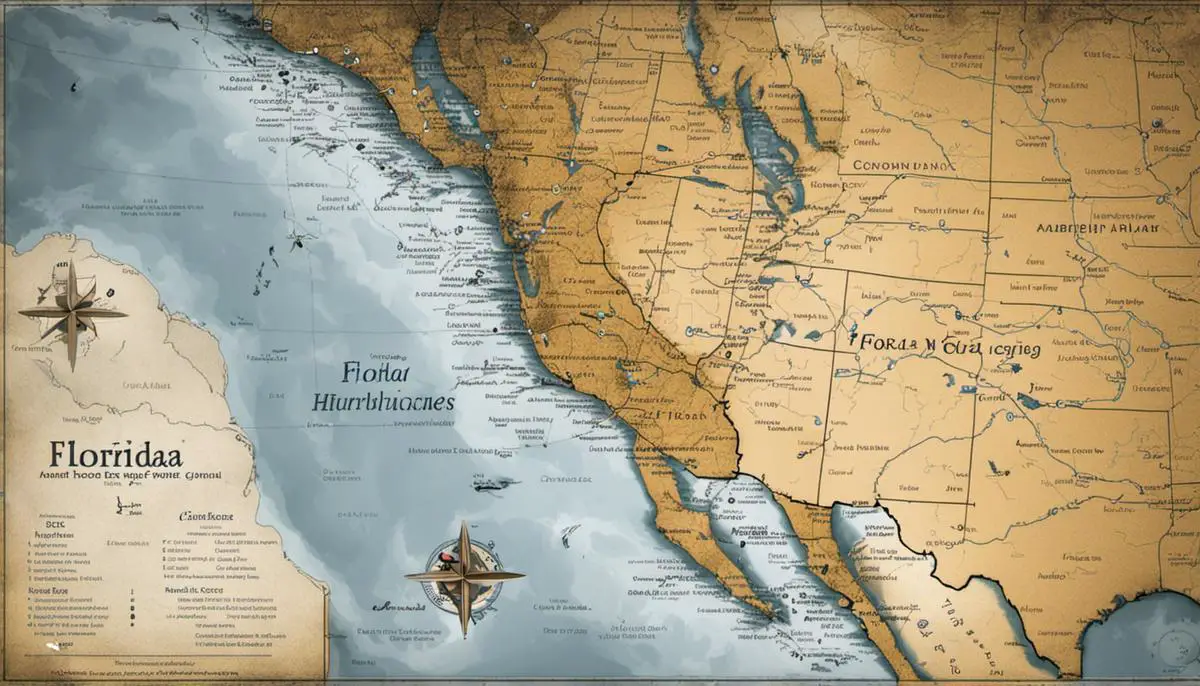
Causes and Environmental Factors
The Role of Geographic and Environmental Factors
Due to its unique geographic characteristics, Florida frequently finds itself in the crosshairs of hurricanes. Occupying a peninsula and situated between the tropical Atlantic Ocean on the east, and the Gulf of Mexico on the west, it is highly susceptible to hurricane development. The warm waters from these bodies of water effectively act as hurricane fuel, creating conditions ideal for their development. Florida’s low-lying topography further enhances its vulnerability, exposing it to the potentially devastating effects of hurricane’s strong winds and heavy rainfall.
Climate Factors and the Atlantic Hurricane Season
Florida’s climate further contributes to its hurricane vulnerability. The state experiences a tropical climate, with hot, humid summers. These conditions, when combined with the atmospheric instability caused by the collision of air masses from North America and the Atlantic, create the perfect setting for hurricanes to form and strengthen.
The Atlantic Hurricane Season, which officially runs from June 1 to November 30, is a time when these conditions are particularly prevalent. During this period, warmer water temperatures and favorable wind patterns increase the potential for hurricane formation and heights their intensity.
What Causes Hurricanes?
The formation of a hurricane starts over warm ocean waters (typically 80°F or warmer). Here, heat and moisture rise into the atmosphere, creating an area of low pressure beneath. Air from the surrounding areas rushes in to fill this void, leading to a swirling mass of clouds with powerful winds and rain. Hurricanes increase in strength by sucking up more warm, moist air from the sea and continue to grow as long as they remain over warm water.
Why is Florida frequently hit by severe hurricanes?
Florida’s geographic positioning renders it particularly susceptible to storm activity. The Peninsula State doesn’t only face the brunt of the regional storms, but also bears the impact of hurricanes originating as far away as the West African coast, known as Cape Verde storms. These hurricanes use the expansive Atlantic Ocean as a highway to gain strength before making landfall in Florida or other eastern parts of the United States.
Standing out with its longest coastline among all U.S. states, Florida’s vulnerability to hurricanes is further heightened. Factors such as geography, climate, and ecosystem, combined with its situation directly in the trajectory of most Atlantic hurricanes, contribute to Florida facing a far greater risk than most other regions. During the Atlantic Hurricane Season, the amalgamation of these factors render Florida a bullseye for some of the continent’s most intense hurricanes.

Impact of Severe Hurricanes
The Economic Repercussions of Severe Hurricanes on Florida
Major hurricanes can wreak havoc on Florida’s economy, hitting several sectors hard. The tourism industry, a cornerstone of Florida’s economy, often bears the brunt of these natural calamities. The hospitality sector, including businesses related to food services and travel, face a severe blow due to canceled reservations and postponed future bookings during hurricane threats. Furthermore, theatening weather conditions could lead to significant supply chain disruptions, damage to business establishments, and a slump in customer spending, resulting in substantial losses for retail businesses.
Insurance Impacts of Severe Hurricanes in Florida
Insurance is another sector heavily impacted by severe hurricanes. Challenges for insurance companies increase as property and casualty claims spike during hurricanes. These increased claims affect the profitability of insurance companies and often lead to higher insurance premiums for Florida residents.
Infrastructure Impacts of Severe Hurricanes in Florida
Furthermore, damaged infrastructure like roads, bridges, power grids, and public buildings require extensive repair and rehabilitation, adding billions of dollars to public expenses, which can take years to recover from.
Environmental Impacts of Severe Hurricanes in Florida
Hurricanes also evoke major environmental consequences in Florida. These natural phenomena cause physical disruption of ecosystems through storm surges, heavy rainfalls, and strong winds. They can significantly disrupt bird migration routes, displace, and destruct aquatic populations, and damage local flora.
Coastal areas witness habitat destruction and changes in landscape due to soil erosion and declined water quality that may increase morbidities in aquatic life. Increased debris and pollution due to hurricanes put further stress on the environment, making recovery slow and labored.
Societal Impacts of Severe Hurricanes in Florida
There is also an immense societal impact when severe hurricanes strike Florida. They disrupt everyday life, leading to displacement of communities, loss of loved ones, and significant destruction of personal property.
These events can lead to emotional stress and trauma among the affected population, leading to myriad mental health issues. The recoveries are not usually swift, with some families displaced permanently due to the economical or personal toll of these hurricanes.
Furthermore, severe hurricanes result in closures of schools, public institutions, businesses, and disruption of public services like health care, which affects the education, livelihood, and healthcare access of thousands of people. Communities also experience increased crime rates following severe hurricanes due to scarcity of essential resources.
Wrapping Up
In summarizing, Florida bears a particularly high susceptibility to intense hurricanes, which have large-scale economic, environmental, and societal consequences. Because of these hefty impacts, it’s deemed crucial to prepare effectively and implement robust recovery strategies. This approach helps in minimizing the damage incurred and promotes swift rehabilitation after such catastrophic events.
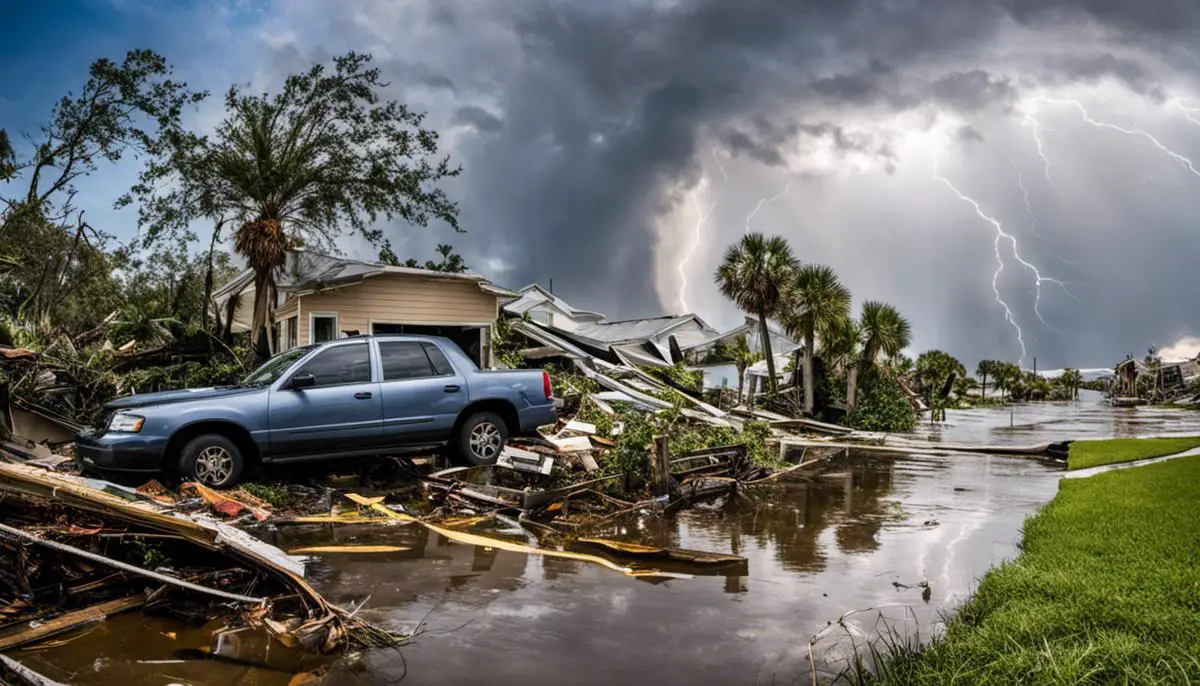
Preparedness and Response to Severe Hurricanes
The Necessity of Hurricane Preparedness in Florida
Florida’s primary line of defense against hurricanes is well-grounded preparation. Managed by the Florida Division of Emergency Management, an extensive plan is in place to both combat and recover from these natural disasters swiftly. The strategy includes the design and implementation of emergency response mechanisms, coordination of resources, and extensive training of first responders and emergency management officials. It also ensures that hurricane shelters and evacuation pathways are adequately maintained.
That said, state-led preparation is only part of the solution; residents play an equally vital role in hurricane readiness. It’s vital for Floridians to prepare individual plans that suit their family’s needs. Such plans often include provisions for adequate supplies of food, water, and medicine, as well as essential items in case of a power outage. Floating on top of this, it’s essential for residents to cultivate the habit of staying informed about approaching storms through various channels, including news outlets, weather radios, and state-provided resources such as the Florida Storms app or the Florida Disaster website.
Response to Severe Hurricanes in Florida
Once a hurricane has passed, the focus shifts to response and recovery. Local municipalities lean heavily on their pre-established disaster response plans, which often include mobilizing first responders to assess, rescue, and provide emergency relief. Nearby unaffected counties and states, often reciprocate aid as well – providing additional resources for search and rescue, medical aid, law enforcement, and more.
Beyond immediate rescue and relief efforts, local utilities work diligently to restore power and water service. Waste management also becomes a priority to avoid health risks associated with garbage pile-up and sewage back-ups.
The Role of State and National Agencies
State and national agencies play a pivotal role in post-hurricane recovery. The Florida Division of Emergency Management is responsible for coordinating statewide recovery efforts, while FEMA – the Federal Emergency Management Agency – steps in with resources and support for both individuals and local governments.
State and national agencies also assist in assessing the extent of damage to apply for federal disaster declarations. These declarations open up access to disaster relief funding, which greatly aids in the recovery process. This relief aids in various forms such as low-interest loans for businesses and homeowners for repairs and rebuilding, unemployment benefits for individuals who lost their jobs as a direct result of a disaster, and public assistance for local governments to help with the cost of debris removal, emergency protective measures, and rebuilding infrastructure.
The Urgency of Building Resilience
With the rising frequency of severe hurricanes, it has become increasingly essential for Florida to reinforce resilience and adapt to these changes. There’s a need to enhance the resistance of infrastructure, upgrade building codes, and reform zoning laws, to help reduce the adverse impacts of future storms. We should also stress the significance of strengthening natural defenses such as beaches, swamps, and mangroves as they act as a shield against hurricane winds and sea surges. It’s equally vital to keep learning from previous hurricane experiences to continuously improve our planning and response strategies.
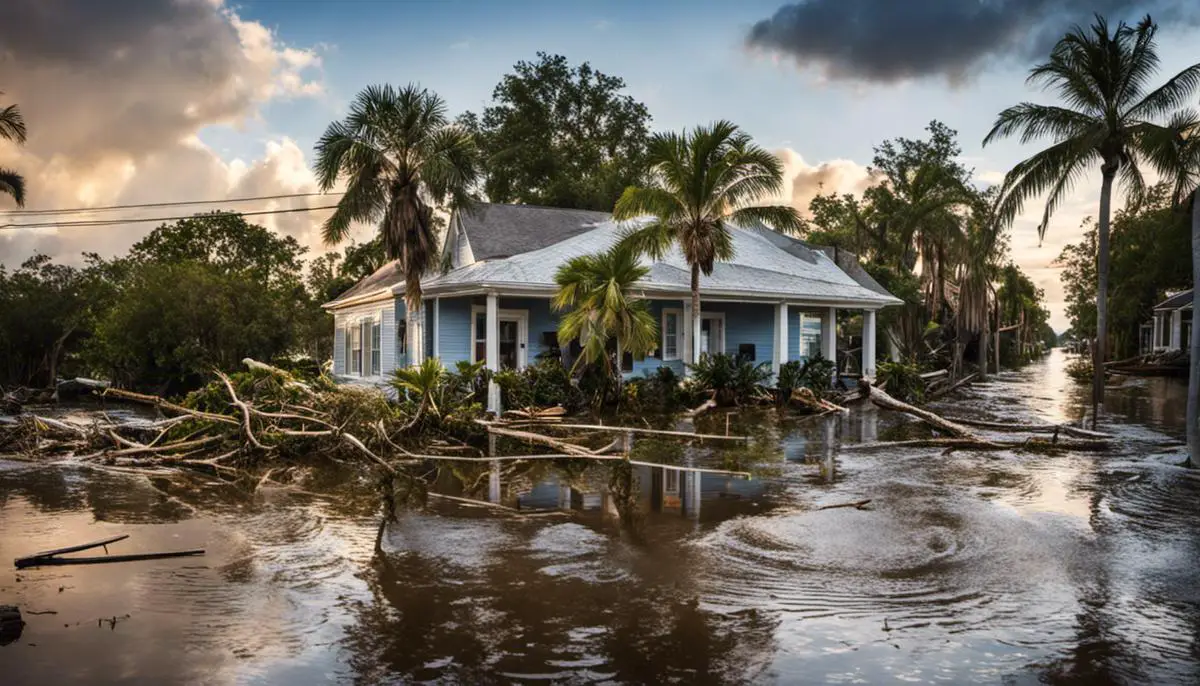
Future Outlook on Severe Hurricanes in Florida
Grasping Hurricanes in an Evolving Climate
Given the current climate change scenario, the projection of severe hurricanes in Florida has become a topic of considerable concern. Hurricanes, being among the fiercest of natural disasters, are a significant threat to Florida, specifically due to its extensive coastal regions. It’s widely accepted that climate change, mainly characterized by global warming, is impacting the frequency and intensity of hurricanes.
In the recent past, climate researchers have been tirelessly striving to comprehend the role of climate change on hurricane activity potential going forward. The National Climate Assessment has indicated that warmer atmospheric conditions could escalate the intensity, precipitation rates, and the resulting flooding caused by hurricanes. Also, higher sea surface temperatures could enhance the strength of hurricanes, making them potentially even more devastating.
With Earth’s surface temperature having increased faster since the mid-20th century than in any other period in recorded history, the scientific community’s forecast concerning hurricane activity is becoming progressively more worrisome.
Increased Frequency and Intensity of Hurricanes
Florida, endearingly referred to as the Sunshine State, often finds itself in the line of fire during the Atlantic hurricane season. Under the influence of climate change, the frequency and intensity of such storms are predicted to increase. The Fifth Assessment Report of the Intergovernmental Panel on Climate Change (IPCC) suggests a likely increase in the occurrence of the strongest (Category 4 and 5) cyclones in the coming years, with a possible decrease in the frequency of weaker storms.
Emerging simulations suggest a rise in hurricane rainfall rates, increased storm intensity, longer storm durations, and more rapid intensification, all of which contribute to greater storm surge risk further amplified by rising sea levels.
Preparing for the Threat of Future Hurricanes
Addressing the prospect of more severe hurricanes in Florida, strategies for adaptation are crucial. Disaster-management measures, such as improved forecasting systems, advanced warning procedures, and effective evacuation plans, are vital to minimizing loss.
Moreover, enforcing stringent building codes and coastal zoning regulations can help ensure properties are better equipped to withstand severe weather events. Developing infrastructure with resilient materials and designs can significantly reduce the damage caused by powerful hurricanes and enhance the speed of recovery post-event.
Education and awareness campaigns around understanding hurricane categories, the hazards associated with each, and clear guidance on preparation steps can drastically improve community resilience.
Longer-term strategies could include restoring and preserving natural barriers such as mangroves and wetlands that naturally help deter the effects of hurricanes, and implementing “managed retreat” strategies, where communities are progressively phased out of highly vulnerable areas.
Climate Change Mitigation to Limit Future Hurricane Risks
While adaptation strategies help manage increased hurricane threats, mitigation measures are also necessary to address the root cause. Limiting greenhouse gas emissions at all scales—local, regional, and global—is fundamental. Transitioning towards renewable energy sources, promoting energy efficiency, and safeguarding and enhancing natural carbon sinks like forests can contribute to slowing the rate of climate change, thus helping to limit the exacerbation of hurricane hazards
In this context, Florida’s potential in solar and wind energies could play a major role.
In conclusion, Florida faces an increased risk of more frequent and severe hurricanes due to climate change. The need for robust adaptation and mitigation strategies is apparent, for the Sunshine State to weather this evolving storm of climatic challenges.
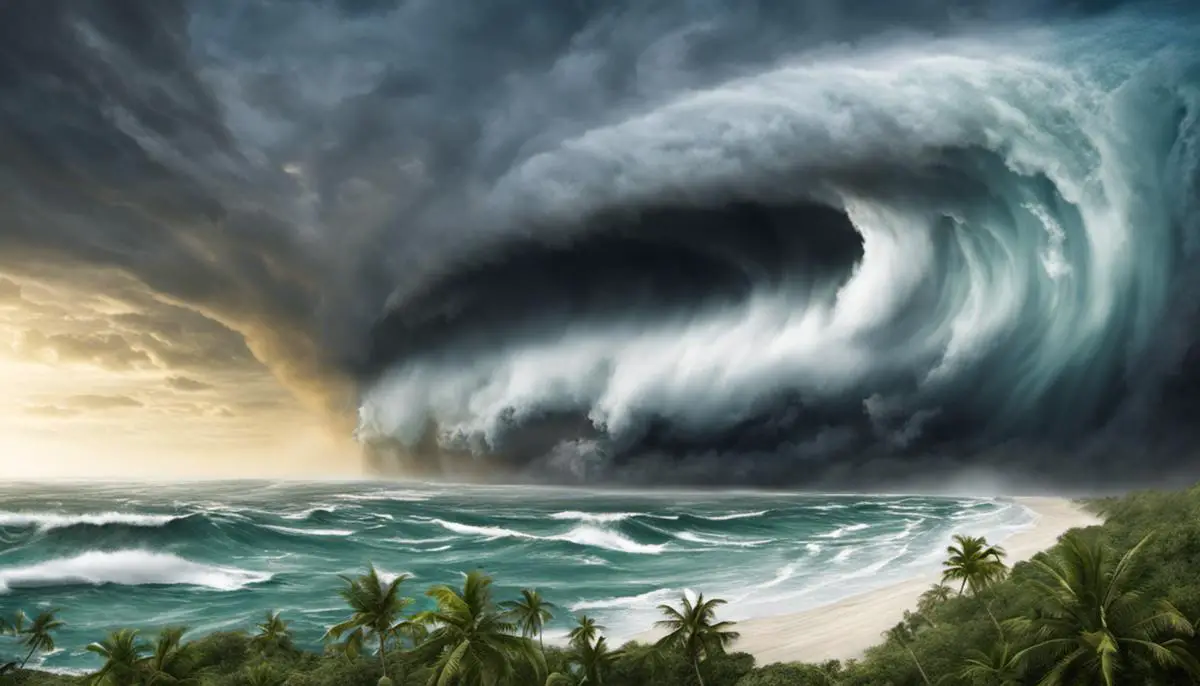
Understanding the phenomenon of severe hurricanes in Florida is not just about evaluating past events or predicting future scenarios; it’s about weaving these threads together to create a comprehensive picture that allows for informed preparation and timely responses. It’s a testament to the resilience of the people and the adaptability of the systems in place. From history to the environment, to the socioeconomic fabric of the state, severe hurricanes touch every aspect, challenging and shaping Florida in profound ways. As climate change patterns continue to develop, and as experts explore varying predictions, one thing remains certain: the readiness and the resilience of Floridians will continue to be tested, calling for even more efficient preparedness and adaptation strategies. The story of hurricanes in Florida is a vital chapter in understanding the state’s broader narrative and its future outlook, one that is continually being written with the ebb and flow of the wind and water.

